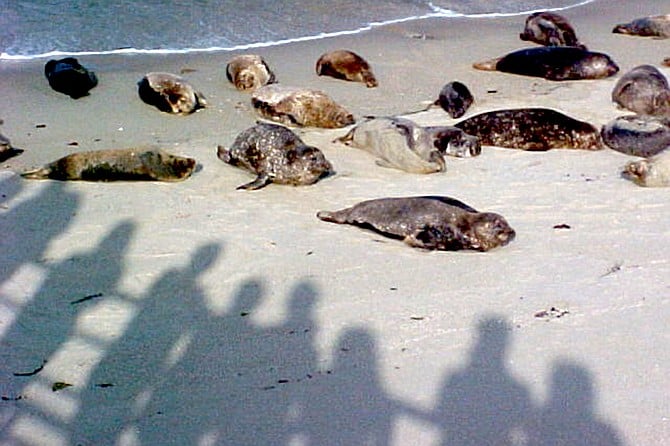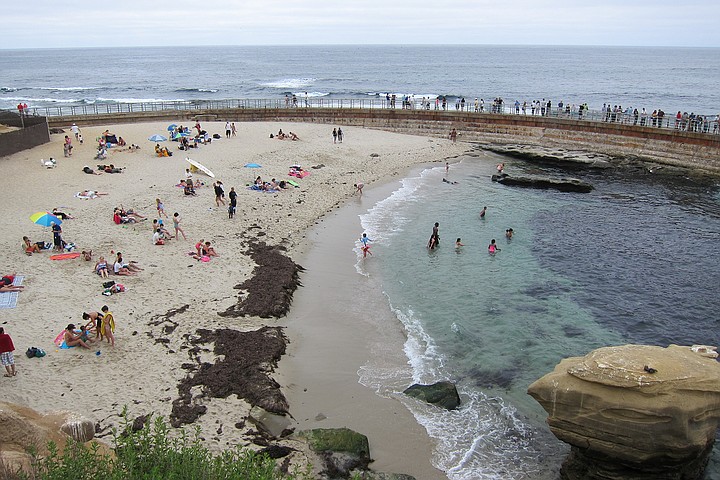 Facebook
Facebook
 X
X
 Instagram
Instagram
 TikTok
TikTok
 Youtube
Youtube

Pupping season at the Children’s Pool in La Jolla just ended and the pool area reopened to the public last week, just in time for the latest in the fight over human access to the protected cove, created by the 1931 construction of a 300-foot breakwater donated by Ellen Browning Scripps.
Five years after the California Coastal Commission gave the city permission to close the lower beach at the manmade pool from December to May for five years, the permit is returning to the coastal commission for review and a requested extension.

Opponents say the city hasn’t met conditions the coastal commission set in the 2014 and 2015 permits – particularly the mandated quest to provide access for handicapped people – but also to look for ways to clean up the feces-contaminated sand and pool.
The only public access ramp to the beach remains blocked by a concrete block retaining wall, says Ken Hunrich, president of Friends of the Children’s Pool. Hunrichs has now compelled the city to review of its actions at the cove.
While the city’s permit to build the lifeguard tower included a ramp to the beach for emergency vehicles and stairs for public access, the city failed to deliver on the promised ramp, he contends. The emergency access ramp could also serve as a wheelchair access point, he argues.
“They built a 30-inch retaining wall that blocks the only public access ramp down to the beach, and that means my friend, Jack Robertson, a strong swimmer who’s paraplegic, can’t get there on his own without dragging himself,” Hunrichs says. “We think the city cited a code section that isn’t applicable here and we want them to review whether the city is in compliance with the Coastal Development Permit.”
The lifeguard tower is built on a middle level below the bluff top park and above the lower beach. It has restrooms and access to the walkway atop the breakwater, and meets the handicap access requirements under the Americans with Disabilities Act, the city says. This is the most recent of many fights in the seven-tenths of a mile cove where seal lovers say millions of tourists and hundreds of seals jostle for access with divers, swimmers and children. It’s one of few spots along the California coast where the coastal commission’s decisions demonstrate that its mission is the most access to the coast that’s possible, rather than unlimited access.
Since the fight for access to the pool began, a handful of La Jolla-based nonprofit groups have formed specifically for Children’s Pool harbor seal issues, including the Seal Conservancy (1999), Friends of Children’s Pool and the Seal Society of San Diego. Most recently, in June 2018, the 4th District Court of Appeals reversed a lower court ruling that would have ended the beach closure from Dec. 15 to May 15..
A year before that, the city built 36-inch gates to keep the seals from climbing to the viewing level to lounge about and sun themselves, and sometimes acting aggressively toward people. The city also installed signs saying “No Selfies With Seals.”
This time, the fight centers on a 30-inch retaining wall the city built in 2015 as part of a project to construct a new lifeguard tower. In response to Hunrichs’s questions about why the barrier was built, the city cited a building code section that requires such a wall if there's a dangerous drop-off ahead. Why anyone wants access to the pool is unclear; both the sand and the water have been declared fecally filthy. The city was asked about the review and the project on May 16 but was unable to respond before today. The OpenDSD site shows that the review to see if the finished project conforms to the permit it issued has begun.


Pupping season at the Children’s Pool in La Jolla just ended and the pool area reopened to the public last week, just in time for the latest in the fight over human access to the protected cove, created by the 1931 construction of a 300-foot breakwater donated by Ellen Browning Scripps.
Five years after the California Coastal Commission gave the city permission to close the lower beach at the manmade pool from December to May for five years, the permit is returning to the coastal commission for review and a requested extension.

Opponents say the city hasn’t met conditions the coastal commission set in the 2014 and 2015 permits – particularly the mandated quest to provide access for handicapped people – but also to look for ways to clean up the feces-contaminated sand and pool.
The only public access ramp to the beach remains blocked by a concrete block retaining wall, says Ken Hunrich, president of Friends of the Children’s Pool. Hunrichs has now compelled the city to review of its actions at the cove.
While the city’s permit to build the lifeguard tower included a ramp to the beach for emergency vehicles and stairs for public access, the city failed to deliver on the promised ramp, he contends. The emergency access ramp could also serve as a wheelchair access point, he argues.
“They built a 30-inch retaining wall that blocks the only public access ramp down to the beach, and that means my friend, Jack Robertson, a strong swimmer who’s paraplegic, can’t get there on his own without dragging himself,” Hunrichs says. “We think the city cited a code section that isn’t applicable here and we want them to review whether the city is in compliance with the Coastal Development Permit.”
The lifeguard tower is built on a middle level below the bluff top park and above the lower beach. It has restrooms and access to the walkway atop the breakwater, and meets the handicap access requirements under the Americans with Disabilities Act, the city says. This is the most recent of many fights in the seven-tenths of a mile cove where seal lovers say millions of tourists and hundreds of seals jostle for access with divers, swimmers and children. It’s one of few spots along the California coast where the coastal commission’s decisions demonstrate that its mission is the most access to the coast that’s possible, rather than unlimited access.
Since the fight for access to the pool began, a handful of La Jolla-based nonprofit groups have formed specifically for Children’s Pool harbor seal issues, including the Seal Conservancy (1999), Friends of Children’s Pool and the Seal Society of San Diego. Most recently, in June 2018, the 4th District Court of Appeals reversed a lower court ruling that would have ended the beach closure from Dec. 15 to May 15..
A year before that, the city built 36-inch gates to keep the seals from climbing to the viewing level to lounge about and sun themselves, and sometimes acting aggressively toward people. The city also installed signs saying “No Selfies With Seals.”
This time, the fight centers on a 30-inch retaining wall the city built in 2015 as part of a project to construct a new lifeguard tower. In response to Hunrichs’s questions about why the barrier was built, the city cited a building code section that requires such a wall if there's a dangerous drop-off ahead. Why anyone wants access to the pool is unclear; both the sand and the water have been declared fecally filthy. The city was asked about the review and the project on May 16 but was unable to respond before today. The OpenDSD site shows that the review to see if the finished project conforms to the permit it issued has begun.
Comments